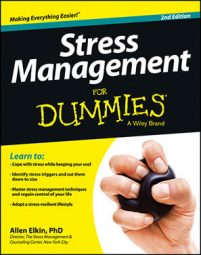Here are three ways to get in the habit of de-stressing. Developing day-to-day habits for home and work will ultimately help you live a less stressful life. For example, the simple act of taking a break and doing a few stretches can really reduce the effects of stress at work. And has it occurred to you that if you do more fun things in life — hang out with friends or spend time on a hobby — you’ll be better able to deal with stress?
Make an appointment with yourself
When you schedule something, you’re more likely to follow through with it. You almost always show up for appointments with your doctor, your dentist, your lawyer, your accountant, your dinner date, and the person who cuts your hair. So why not use that same principle for other things in your life, like managing your stress? Try some of the following suggestions:
Schedule regular times during the week when you will do something to manage your stress. Make Thursdays Lunch-with-a-Friend Day. Schedule Monday and Wednesday evenings as health club times.
Make your coffee break a stress break. Set aside a few minutes mid-morning and mid-afternoon to drain some of that accumulating tension from your mind and body.
Commit part of each lunch hour to some stress-reducing activity. Go to the gym or try meditating in a nearby park for 20 minutes.
Designate specific chunks of time during your week as times when you do the kinds of activities you normally wouldn’t. While these activities will be specific stress-management techniques, they can also be activities that are diverting and relaxing — listening to music, taking in a film, going for a swim, and playing squash or tennis.
Keep a log of de-stressing activities
Try this suggestion for at least an entire day. On your laptop, tablet, or smartphone, or simply on an index card or scrap piece of paper, make a note of when you did something to reduce your stress. Be brief, making sure that your record-keeping doesn’t add to your existing stress level. The table shows some sample entries.
| Time | Where | What I Did |
|---|---|---|
| 9:30 a.m. | Bedroom | Meditated for 15 minutes |
| 10:20 a.m. | Kitchen | Practiced deep breathing |
| Lunchtime | On the street | Did some stretching |
| 3:30 p.m. | In the car stuck in traffic | Did some rapid relaxation |
| 4:30 p.m. | Waiting for the elevator | Practiced relaxed breathing |
You get the idea. You may find that by monitoring your stress-management attempts, you’ll become more conscious of doing them and of doing them more often. Try it.
Become a freelance, unpaid, stress-management guru
The topic of stress frequently comes up in conversation, and if it doesn’t, you can always bring it up yourself. When you do, you may find that most people have a great interest in your stress-management activities. People will ask you how you handle your stress.
Tell them. In fact, show them. One of the best ways of mastering something is by teaching it to others. Teach a friend or interested listener one or more of your favorite stress-management techniques. You’ll begin to feel somewhat proprietary about these tools and, as a result, feel more motivated to use them yourself.

